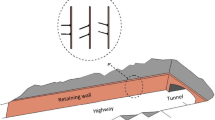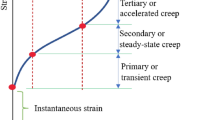Abstract
It is important to estimate the probability of fracture extension and its impact on the safety of arch dams with fractures. Numerical simulation and geomechanical model test were combined to evaluate the overall stability and the extension probability of fractures. Numerical simulation forecasted the dam displacement and the operating behavior based on the parameters obtained from the back analysis. Geomechanical model test was based on small block masonry and the models with or without fractures were both tested. The results show that the deformation of dams is in line with general rules at a normal water load and the extension probability of the existing fractures is very small, which has no significant impact on the global stability of dams. Moreover, the failure process of arch dams with the existing fractures in dams at overload scenarios is similar to the one without the embedded fractures, i.e., the failure crack which is not caused by the existing fractures inside comes into being on the surface of dams itself.
Similar content being viewed by others
References
Pan J W, Feng Y T, Xu Y J, et al. Chemo-damage modeling and cracking analysis of AAR-affected concrete dams. Sci China Tech Sci, 2013; 56: 1449–1457
Linsbauer H N, Ingraffea A R, Rossmanith H P, et al. Simulation of cracking in large arch dam: Part I. J Struct Eng, 1989, 115: 1599–1615
Ru N H, Jiang Z S. Arch Dams-incidents and Safety of Large Dams. Beijing: China Water Power Press, 1995. 19–23
Liu Y R, Guan F H, Yang Q, et al. Geomechanical model test for stability analysis of high arch dam based on small blocks masonry technique. Int J Rock Mech Min Sci, 2013; 61: 231–243
Wang H X, Wang Q Y, Zheng Y H. Bifurcation analysis for Hindmarsh- Rose neuronal model with time-delayed feedback control and application to chaos control. Sci China Tech Sci, 2014; 57: 872–878
Lu L L, Shi Y C, Chen X F. First demonstration of 1.3 µm quarter- wavelength shift distributed feedback (DFB) semiconductor laser based on conventional photolithography. Sci China Tech Sci, 2013; 56: 554–557
Sakurai S, Takeuchi K. Back analysis of measured displacements of tunnels. Rock Mech Rock Eng, 1983; 16: 173–180
Zhou W Y, Yang R Q, Liu Y R, et al. Research on geomechanical model of rupture tests of arch dam for their stability. J Hydroelec Eng, 2005; 24: 53–58
Alvarez M A. Mechanical models as compared with mathematics. In: Proceedings of the International Colloquium on Geomechanical Model. Bergamo, Italy: ISRM, 1979. 149–151
Fu S J, He T, Wang G J, et al. Evaluation of cracking potential for concrete arch dam based on simulation feedback analysis. Sci China Tech Sci, 2011; 54: 565–572
Wang W M, Ding J X, Wang G J, et al. Stability analysis of the temperature cracks in Xiaowan arch dam. Sci China Tech Sci, 2011; 54: 547–555
Liu Y R, Wang J, Yang Q, et al. Research on influences of cracking of Xiaowan arch dam on its stress and stability. Chin J Rock Mech Eng, 2010; 29: 1132–1139
Fumagalli E. Stability of arch dam rock abutments. In: Proceedings of first ISRM Congress, Lisbon, Portugal: ISRM, 1966. 503–508
Wang H P, Li S C, Zheng X F. Research progress of geomechanical model test with new technology and its engineering application. Chin J Rock Mech Eng, 2009; 28: 2765–2771
Zhu W S, Li Y, Li S C, et al. Quasi-three-dimensional physical model tests on a cavern complex under high in-situ stresses. Int J Rock Mech Min Sci, 2011; 48: 199–209
Lemos J V, Pina C A B, Costa C P, et al. Experimental study of an arch dam on a jointed foundation. In: Proceedings of the Eighth ISRM Congress, Tokyo, Japan, ISRM, 1995. 1263–1266
Guan F H, Liu Y R, Yang Q. Research on anchorage of dam toe of Baihetan high arch dam. Chin J Rock Mech Eng, 2010, 29: 1323–1332
Zhang L, Liu Y R, Yang Q. Evaluation of reinforcement and analysis of stability of a high-arch dam based on geomechanical model testing. Rock Mech Rock Eng, 2014: 1–16
Cividini A, Jurina L, Gioda G. Some aspects of ‘characterization’ problems in geomechanics. Int J Rock Mech Min Sci, 1981, 18: 487–503
Hjiaj M, Fortin J, De Saxcé G. A complete stress update algorithm for the non-associated Drucker–Prager model including treatment of the apex. Int J Eng Sci, 2003; 41: 1109–1143
Schreyer H L, Kulak R F, Kramer J M. Accurate numerical solutions for elasto-plastic models. J Press Vess-T, ASME, 1979, 101: 226–234
Zhou W Y, Yang Q. Numerical Computational Methods for Rock Mechanics. Beijing: China Electric Power Press, 2005. 84–85
Chen X, Yang Q, Huang Y S, et al. Sub-incremental method for perfect elasto-plastic material based on D-P yield criteria. Chin J Rock Mech Eng, 2002; 2: 2465–2469
Ortiz M, Popov E P. Accuracy and stability of integration algorithms for elastoplastic constitutive relations. Int J Numer Meth Eng, 1985; 21: 1561–1576
Kavanagh K T, Clough R W. Finite element applications in the characterization of elastic solids. Int J Solids Struct, 1971; 7: 11–23
Lei X Y, Swoboda G, Zenz G. Application of contact-friction interface element to tunnel excavation in faulted rock. Comput Geotech, 1995; 17: 349–370
Wang Z H, Gao L S, Song W J. Finite element analysis of 3-D friction-contact problems. J Tsinghua Univ (Sci & Tech), 2002; 42: 93–96
Author information
Authors and Affiliations
Corresponding author
Rights and permissions
About this article
Cite this article
He, Z., Liu, Y., Pan, Y. et al. Evaluating the safety of high arch dams with fractures based on numerical simulation and geomechanical model testing. Sci. China Technol. Sci. 58, 1648–1659 (2015). https://doi.org/10.1007/s11431-015-5855-7
Received:
Accepted:
Published:
Issue Date:
DOI: https://doi.org/10.1007/s11431-015-5855-7




